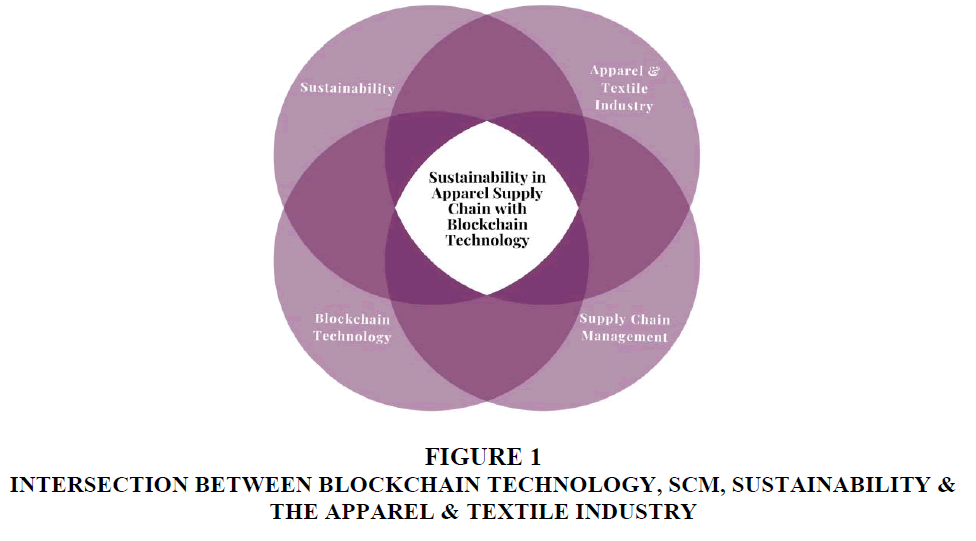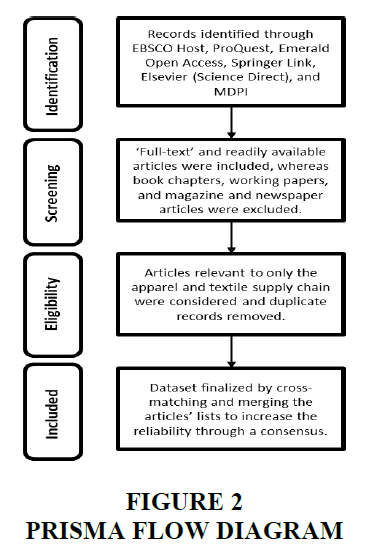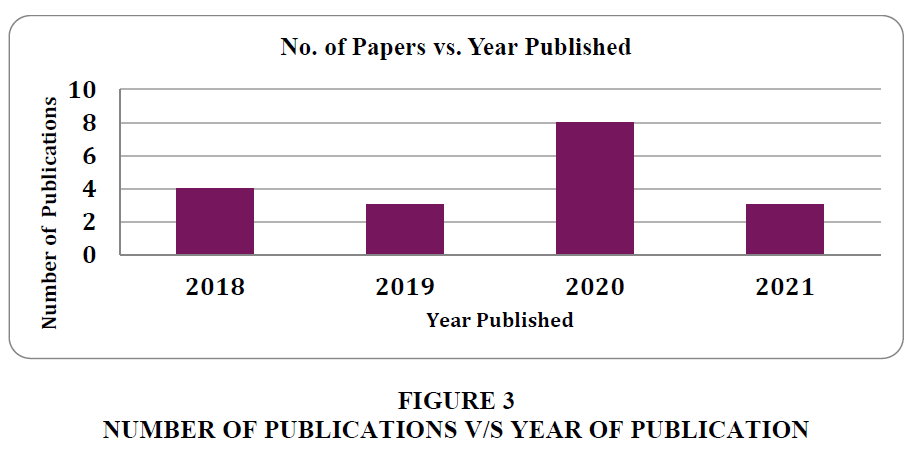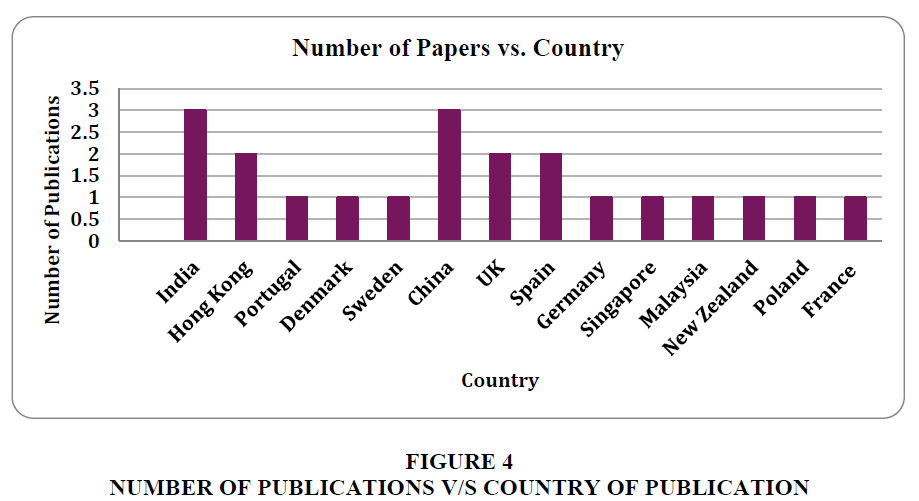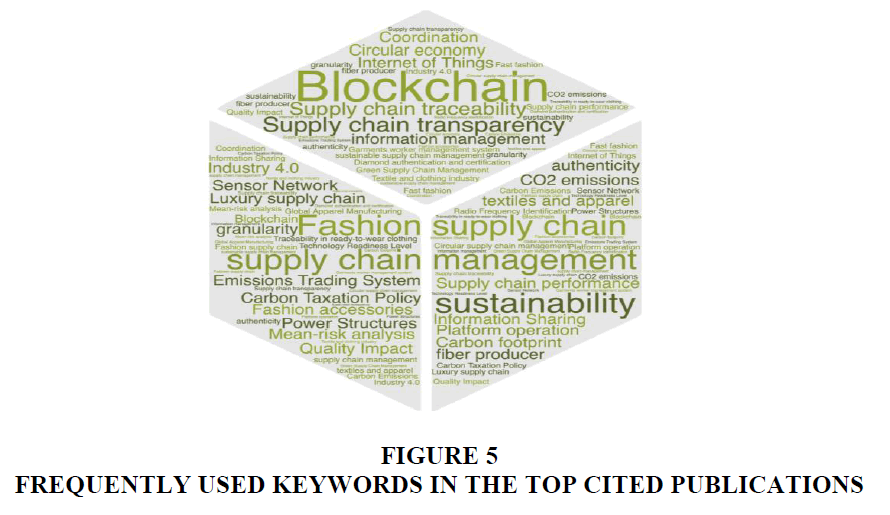Research Article: 2022 Vol: 26 Issue: 2
Sustainability In Apparel and Textile Supply Chains With Blockchain Technology: A Bibliometric Analysis
Mohit Saxena, Indian Institute of Foreign Trade (IIFT), New Delhi
Tarannum Saxena, National Institute of Fashion Technology, New Delhi
Nitin Seth, Indian Institute of Foreign Trade (IIFT), New Delhi
Citation Information: Saxena, M., Saxena, T., & Seth, N. (2022). Sustainability in apparel and textile supply chains with blockchain technology: A bibliometric analysis. Academy of Marketing Studies Journal ,26(2), 1-9.
Abstract
This study examines the three areas of research-Apparel Industry, Supply chain management (SCM), Sustainability, and Blockchain Technology. Furthermore, this study provides a structured literature review for the literature on the role of Blockchain Technology in Sustainable Apparel Supply Chain Management. The current study aims to analyze the thematic structures and trends of scientific publications that examine the use of blockchain for sustainability implementation in fashion supply chains, by a bibliometric analysis that provides insights not previously understood or evaluated by other such reviews on the topic, while presenting a roadmap for future research.
Keywords
Sustainable Supply Chain, Blockchain Technology, Traceable Supply Chain, Apparel and Textile Supply Chain.
Introduction
This review paper examines the intersection of four areas of research-Apparel and Textile Industry, Supply chain management (SCM), Sustainability, and Blockchain Technology as depicted in Figure 1. It focuses on blockchain-based applications and understanding the influence of blockchain technology on future supply chain practices in the apparel industry.
Figure 1 Intersection Between Blockchain Technology, SCM, Sustainability & the Apparel & Textile Industry
While the literature in this area started appearing in 2018, to the best of our knowledge, this is the first extensive structured review of the subject with respect to sustainability in the Apparel Industry. Furthermore, this study provides a literature review and a classification framework for the literature on the role of blockchain Technology in Sustainable Apparel and Textile Supply Chain Management using bibliometric analysis. Subsequently, it introduces Sustainable SCM, owing to the study’s focus on sustainability in the supply chain context, along with an introduction of how blockchain technology is relevant to Sustainability in Apparel and Textile SCM (Manupati et al., 2019; El-Messiry & El-Messiry, 2018).
Apparel Supply Chain
The Textile & Apparel (T&A) supply chain is a complex network with multiple materials, complicated processes, and several suppliers and partners at each production step. Due to shifting and varying consumer choices and trend-based consumerism, T&A products have a short shelf-life with numerous styles and collections every season (Thomassey, 2010).
A fiber producer (natural fiber or industry producing petroleum-based chemical fibers) is the first link in a traditional T&A supply chain. These fibers are subsequently spun into yarn by the yarn-manufacturing units and then transformed to fabric through weaving, knitting, or nonwoven processes. These fabrics are then forwarded to apparel manufacturing units where they are fashioned into garments, accessories or furnishings. The supply chain also includes the sub-suppliers and contractors providing trims and value add-ons (e.g. buttons, threads, chemical treatment, embroideries, etc.) Fashion brands (usually the retailers), are the focal firms in the T&A supply chain. They primarily drive the supply chain configuration by purchasing finished textile products from upstream suppliers and selling them to end consumers, based on various factors, including low-cost production location, suppliers’ track record, and consumer market (Agrawal et al., 2021).
Globalization has served a significant role in the offshoring and outsourcing of T&A manufacturing to locations with more flexible laws, cheaper labor, and greater availability of supplies, hence lowering the risk by not owning any manufacturing units, making the supply chain adaptable and flexible. The supply chain therefore consists of a dispersed manufacturing network, each having a series of complex operations. However, due to geographical separation and institutional differences between different partners, effective information sharing has become crucial and inadequate information sharing hinders the flexibility and synchronized operations of the T&A supply chain (Kumar et al., 2017; Wang et al., 2020; Ahmed & MacCarthy, 2021).
Sustainability
Sustainability can be defined as “the way natural systems function, remain diverse and produce everything they need for the ecology to remain in balance” (James, 2015). The three pillars of sustainability, also referred to as the Triple Bottom Line are - economic performance, social performance, and environmental performance (Carter and Rogers, 2008; Pérez et al., 2020). It is often challenging for businesses to adopt sustainability practices together with improved financial performance.
As a result, some businesses operate without consideration of negative social or environmental impact. Several examples of this oversight can be found in the T&A supply chain. With the emergence of fast fashion in the recent years, the fashion industry has become one of the most polluting industries. It promotes overconsumption, increases the carbon footprint (more raw materials, more energy spent on production, more production and transport from remote locations) and generates more waste (more material to recycle or to be treated as waste), often without regard for social or environmental consequences. Majority of fashion brands have relocated their manufacturing to developing countries, without bothering about who works in those factories, and under what conditions. The fashion industry is a source of exploitation for millions (Choi, 2019), sometimes even using forced and child labor (Baptist World Aid, 2019).
Blockchain Technology
A blockchain is a digitally distributed, decentralized, public ledger that exists across a network. It provides foundations to develop cryptocurrencies like Bitcoin, and it has been proven to be an effective and a safe means of exchanging currency (Investopedia, 2021).
It’s been observed that blockchain has the potential to disrupt a wide range of industries, and not just finance. The advantages of blockchain technology cryptocurrencies have fueled its popularity prompting researchers to look into and analyze its potential implementation in SCM and logistics. Walmart and IBM, for example are known for their blockchain-based supply chain traceability initiatives. In blockchain-based traceability systems, each transaction and action is visible and can be traced and retrieved by multiple parties at any time (Fu et al., 2018)
The tracking of materials and goods across various manufacturing steps, from initial raw materials management to finished goods management, is a major use of blockchain in the T&A business. As an instance of the fashion product made from eco-friendly materials, the promise of blockchain is that it does not necessitate any additional inspections or certifications. The information is unchangeable and publicly viewable once stored in the blockchain system (Guo et al., 2020; Choi, 2020). This becomes essential as the absence of transparency in the supply chains makes it more difficult to hold fashion businesses responsible for the conditions in which their clothing is manufactured and their sustainability commitments. Simultaneously, there is an increase in demand for more sustainable and ethically manufactured products from both consumers and industry players alike. According to Morning Consult's research, 64% of respondents would be more likely to buy a garment if new technology could back up its sustainability claims (Fashion United, 2021).
According to (Queiroz and Wamba, 2019), blockchain–SCM integration is an unexplored field lacking research. Because the supply chains in different industries differ in many ways in terms of features and functionality, it is crucial to investigate the blockchain operations, taking into account its applications and supply chain requirements (Umeh, 2016). In order to do this, we look at some case studies of the application of blockchain in apparel and textile supply chains in the next section and then proceed to analyze the literature on the same.
Methodology
The objective of literature reviews is to map and analyse the body of literature in order to identify potential research gaps and highlight the boundaries of knowledge (Tranfield et al., 2003). Structured literature reviews are usually completed through an iterative cycle of defining relevant search keywords, searching the literature, and completing the analysis (Tranfield et al., 2003).
Network analysis through bibliometric tools can be effective in identifying established and nascent, novel topical areas. It can also help identify the clusters of research and researchers showing how the various areas of thought may have surfaced based on author and institutional characteristics. It paves the way for determining further emergent study fields through capturing the neoteric topics covered by these researchers.
This paper presents a comprehensive evaluation of the field, focusing on blockchain technology in sustainable fashion and textile supply chains, using bibliometric tools and according to the PRISMA Framework (Figure 2).
In this context, Microsoft Excel software was used for the purpose of sorting and calculations. The data obtained were analyzed according to content and categorical analysis of types along with frequency analysis. The findings were then compiled and presented visually through graphs and network diagrams, along with tables.
Results and Discussion
Results derived from the analysis of the articles are presented in the headings below under main themes: (i) distribution of articles over the time; (ii) contributive countries; (iii) methods; (iv) journals; (v) thematic trends; and, (vi) triple bottom line.
Analysis of the Distribution of Articles over the Years
In context of the current study, the publications were analyzed in terms of the distribution over the years and this is presented in Figure 3. It can be observed that the number of articles associated with Sustainability in Apparel and Textile Supply Chain with Blockchain Technology was maximum in 2020. However, it can be asserted that there was a sudden decrease in the number of articles in the following year.
This can be attributed to the fact that like many other trends that were important before the pandemic hit, blockchain didn’t make as many headlines in 2021 as it had done previously (Marr, 2021).
Analysis of the Most Contributive Countries
The top article-contributing countries were examined as one of the main themes within the scope of the current study, and the results are illustrated in Figure 4 It can be observed that the authors of these articles belonged to diverse countries. Additionally, the countries with the most articles contributed were India and China, followed by UK, Spain, and Hong Kong.
Additionally, some articles were published by researchers from more than one country.
Analysis of Trends of Methods in Publications
Results derived after examining the types of publications on the basis of methods has been depicted in Table 1. It can be observed that four different methods were used. The data demonstrates that 7 of the publications presented quantitative research, whereas 4 of the studies were qualitative, 6 were theoretically based, and 1 was conducted as a mixed-method study. Most of the papers in the available literature describe theoretical frameworks and applications of blockchain in the apparel and textile industry.
| Table 1 Types of Publications | |||
| Theoretical | 6 | 42 | 7 |
| Empirical Quantitative | 7 | 333 | 47.57 |
| Empirical Qualitative | 4 | 53 | 13.25 |
| Mixed-Method | 1 | 16 | 16 |
However, some of the articles categorized as theoretical in the current study covered personal views and perspectives of the author(s) and did not include qualitative, quantitative, or mixed methods with no other information regarding the method applied in the studies. While many of the articles were theoretical, determining whether the articles were actually theorizing, criticizing, or developing types of research studies was difficult.
Analysis of the Journals Publishing the Articles Exploring the Relationship between a Sustainable Apparel Supply Chain and Blockchain Technology
In context of this study, it can be stated that a considerable number of articles were published in the journal Sustainability by MDPI. The second journal with the most articles published was the International Journal of Production Research.
Additionally, the data in Table 2 illustrates that the journals that published these articles have a high impact factor.
| Table 2 Journals and Publications | ||
| Sustainability by MDPI | 5 | 3.251 |
| Annals of Operation Research | 1 | 2.583 |
| IEEE Transactions on Engineering Management | 1 | 6.146 |
| Computers & Industrial Engineering | 1 | 5.431 |
| Journal of Business Management and Economic Research | 1 | NA |
| Journal of Physics: Conference Series | 1 | 0.55 |
| International Journal of Production Research | 2 | 8.568 |
Analysis of Thematic Trends of Publications
The most frequently used keywords in the articles, excluding “Blockchain” and “Supply Chain Management”, were “Supply chain transparency (f = 6), Supply chain traceability (f = 5), Fashion supply chain (f = 2), and Sustainability (f = 2).” This has also been depicted in Figure 5.
When the distribution of the articles was examined in terms of the “subject (frequently used keywords)” of research, it was inferred that the publications linking Apparel Supply Chain and Blockchain were focused on “Supply chain transparency” and “Supply chain traceability.”
Analysis of these articles determined that the keyword “Supply Chain” was frequently used together with one or more of the keywords “Traceability, Transparency, and Sustainability”. This helps us understand that the application of blockchain technology in the apparel industry has been limited to only improving the traceability/transparency in the supply chain and other avenues of application remain unexplored.
Triple Bottom Line (TBL) Analysis
For the sixth theme in the context of the current study, a triple bottom line (TBL) analysis was done i.e., the number of papers that covered which aspect of the TBL were analyzed.
From Table 3, it can be observed that the maximum publications focus on the environmental aspect of the Triple Bottom Line as compared to the social and economic. Since most papers focus on improving the transparency and traceability in the supply chain, (as observed in the Figure 5), its direct impact on the environment is apparent.
| Table 3 Triple Bottom Line Analysis | |
| Environmental | 12 |
| Economic | 11 |
| Social | 10 |
Conclusion
This study contributes theoretically by investigating the thematic structures and trends of the publications indexed in various bibliographic databases that specifically examined the use and implementation of blockchain technology in sustainable apparel and textile supply chains.
Numerous and a wide variety of bibliometric studies have not been carried out on the same. In this context, the present study is one of the first in international literature to explore the thematic structures and trends of scientific publications through bibliometric and content analysis.
In conclusion, the results of this study exhibited that a greater number of the literature is focused on Supply Chain Traceability and Transparency and that there is limited research on Blockchain Technology’s use in Sustainable Apparel and Textile Supply chains. In this context, the industry, and academia should encourage possible research on this since Blockchain is a novel technology that is here to stay and can prove to be extremely effective in ensuring that the apparel and textile supply chains remain sustainable.
Limitations and Future Scope
Although the current study exhibited significant findings from examining articles from various bibliographic databases that explored the use of blockchain in sustainable apparel supply chains, it does, however, have some limitations. The articles taken in the study might not be a full and complete representation of all literature available on the said topic, and thus extensive research may be required which takes into account various other databases not accessible to the researchers. Future studies can be undertaken in the gap areas highlighted in the study, such as examining the use of blockchain from the social and economic perspective of sustainability.
References
Agrawal, T.K., Kumar, V., Pal, R., Wang, L., & Chen, Y. (2021). Blockchain-based framework for supply chain traceability: A case example of textile and clothing industry. Computers & Industrial Engineering, 154, 107130.
Indexed at, Google Scholar, Cross Ref
Ahmed, W.A.H., & MacCarthy, B.L. (2021). Blockchain-enabled supply chain traceability in the textile and apparel supply chain: A case study of the fibre producer, lenzing. Sustainability, 13(19), 10496.
Sanders, L., & Mawson, J. (2019). The 2019 ethical fashion report: The truth behind the barcode.
Pérez, J.J., Queiruga-Dios, A., Gayoso-Martínez, V., & Martín, Á. (2020). Traceability of ready-to-wear clothing through blockchain technology. Sustainability, 12(18), 7491.
Indexed at, Google Scholar, Cross Ref
Carter, C.R., & Rogers, D.S. (2008). A framework of sustainable supply chain management: moving toward new theory. International Journal of Physical Distribution & Logistics Management, 38(5), 360–387.
Indexed at, Google Scholar, Cross Ref
Choi, T.M. (2019). Blockchain-technology-supported platforms for diamond authentication and certification in luxury supply chains. Transportation Research Part E: Logistics and Transportation Review, 128, 17–29.
Indexed at, Google Scholar, Cross Ref
Choi, T.M. (2020). Supply chain financing using blockchain: impacts on supply chains selling fashionable products. Annals of Operations Research.
Indexed at, Google Scholar, Cross Ref
El-Messiry, M., & El-Messiry, A. (2018). Blockchain framework for textile supply chain management. Lecture Notes in Computer Science, 10974, 213–227.
Indexed at, Google Scholar, Cross Ref
Agrawal, T. K., Sharma, A., & Kumar, V. (2018). Blockchain-based secured traceability system for textile and clothing supply chain. InArtificial intelligence for fashion industry in the big data era 197-208. Springer, Singapore.
Indexed at, Google Scholar, Cross Ref
Fu, B., Shu, Z., & Liu, X. (2018). Blockchain enhanced emission trading framework in fashion apparel manufacturing industry. Sustainability, 10(4), 1105.
Indexed at, Google Scholar, Cross Ref
Guo, S., Sun, X., & Lam, H.K.S. (2020). Applications of Blockchain Technology in Sustainable Fashion Supply chains: Operational transparency and environmental efforts. IEEE Transactions on Engineering Management, 1–17.
Indexed at, Google Scholar, Cross Ref
Investopedia. (2021). Blockchain explained
James, P. (2015). Urban sustainability in theory and practice: Circles of sustainability. Routledge. Indexed at, Google Scholar, Cross Ref
Kumar, V., Hallqvist, C., & Ekwall, D. (2017). Developing a framework for traceability implementation in the textile supply chain. Systems, 5(2), 33.
Indexed at, Google Scholar, Cross Ref
Manupati, V.K., Schoenherr, T., Ramkumar, M., Wagner, S.M., Pabba, S.K., & Inder, R. (2019). A blockchain-based approach for a multi-echelon sustainable supply chain. International Journal of Production Research, 58(7), 2222–2241.
Indexed at, Google Scholar, Cross Ref
Marr, B. (2021). The six biggest blockchain trends everyone should know about in 2021. Forbes.
Queiroz, M.M., & Wamba, S. (2019). Blockchain adoption challenges in supply chain: An empirical investigation of the main drivers in India and the USA. International Journal of Information Management, 46, 70–82.
Indexed at, Google Scholar, Cross Ref
Thomassey, S. (2010). Sales forecasts in clothing industry: The key success factor of the supply chain management. International Journal of Production Economics, 128(2), 470–483.
Indexed at, Google Scholar, Cross Ref
Tranfield, D., Denyer, D., & Smart, P. (2003). Towards a methodology for developing evidence-informed management knowledge by means of systematic review. British Journal of Management, 14(3), 207–222.
Indexed at, Google Scholar, Cross Ref
Umeh, J. (2016). Blockchain double bubble or double trouble? ITNOW, 58(1), 58–61.
Indexed at, Google Scholar, Cross Ref
Wang, B., Luo, W., Zhang, A., Tian, Z., & Li, Z. (2020). Blockchain-enabled circular supply chain management: A system architecture for fast fashion. Computers in Industry, 123, 103324.
Indexed at, Google Scholar, Cross Ref
Received: 05-Jan-2022, Manuscript No. AMSJ-22-11060; Editor assigned: 07-Jan-2022, PreQC No. AMSJ-22-11060(PQ); Reviewed: 21-Jan-2022, QC No. AMSJ-22-11060; Revised: 24-Jan-2022, Manuscript No. AMSJ-22-11060(R); Published: 30-Jan-2022
